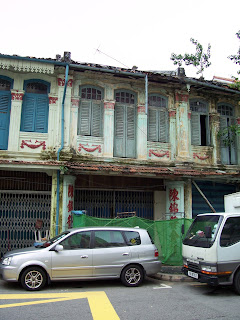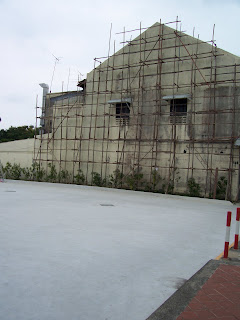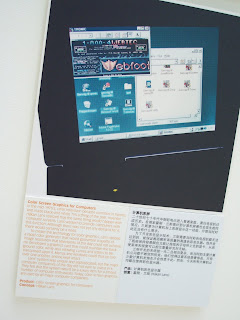...continuing from The Katong/ Joo Chiat Walk

There were quite a number of interesting buildings that I had came across during the walk of the Katong/ Joo Chiat area. Although these buildings were not featured in the
Uniquely Singapore: Katong/ Joo Chiat Walking Guide, it is worth to take some glimpses of them.


Leisurely, I strolled along Tembeling Road while enjoying the temporary peace that the street offered. A yellow-colour building stood out and it was one of the featured places on the Walking Guide.


At 62 Tembeling Road, there is a Chinese temple just beside the yellow-colour building. The temple is known as the
Kuan Im Tng Temple. In the Walking Guide, it is stated that the temple was built in 1921. One should not miss looking at the ornate facade of the temple. One should also take a look at the statues of dancing dragons found on the temple's roof ridges.
 Kuan Im Tng Temple.
Kuan Im Tng Temple.

Further down, along 89 - 103 Joo Chiat Place, I was recommended by the Walking Guide to see the architectural masterpiece of the Lotus at Joo Chiat apartments. Here's quoting from the Walking Guide:
The Lotus at Joo Chiat apartments are a fine example of integrating old shophouses with new flats, and were built in the 1930s in the Late Shophouse style.
I like these shophouses way better than those along Koon Seng Road. Perhaps I was drawn to the air of elegance that these shophouses of Lotus at Joo Chiat exuded.






I continued my journey and headed for
Masjid Khalid, a mosque located at 130 Joo Chiat Road. As I walked towards the mosque, I noticed that the shops nearby the mosque show a distinct Malay influence in their architectural designs.
 Masjid Khalid. Built in 1917, and renovated in 1998, the mosque was originally intended as a place of worship for the Indian Muslims.
Masjid Khalid. Built in 1917, and renovated in 1998, the mosque was originally intended as a place of worship for the Indian Muslims.
 Notice that the architecture of the shophouses in the background appear Malay in its influence.
Notice that the architecture of the shophouses in the background appear Malay in its influence.
I noticed a shop nearby the mosque, and I could not resist the urge to take a photo of the shop. Even an elderly man sitting nearby the shop was beckoning me to take photograph of the shop. I had a feeling that he had thought I was a tourist from foreign lands. Anyway, the shop looked like a carpentry workshop of some sorts. Somehow, I had a premonition that workshops of such layouts may soon vanish from a society that progresses rapidly, unless the rate of preserving our heritage could catch up.

In addition, my hands could not resist taking a photo of a man washing one of the stairways found at the back of a row of shophouses.

My walk continued as I walked towards Joo Chiat Complex. Somehow, walking towards Joo Chiat Complex jolted my memories. I recalled that my mother had brought me to Joo Chiat area for haircut when I was much younger. No wonder some parts of this part of Singapore looked vaguely familiar to me.

 Joo Chiat Complex. This is one place to find Malay textiles and foodstuff.
Joo Chiat Complex. This is one place to find Malay textiles and foodstuff.
During my walk, I noticed that there were probably some restoration works coming up for some of the shophouses. Would restoration give these shophouses new life, or would it make them lose their nostalgic flavour?

***
Too much of walking can be strenuous so I took a short moment of break before moving on. I was not confident of taking too long a break for if you could tell from the photographs, the skies were already turning very dull by then and I was worried that it might rain anytime then.
After the short moment of rest, I walked along Joo Chiat Road and came close to an open space called
Joo Chiat Square. According to
http://myjoochiat.com, Joo Chiat Square was launched by Member of Parliament Chan Soo Sen on 23 Dec 2006. "It is an initiative by the Joo Chiat Citizens' Consultative Committee for a planned programme of wholesome family and community activites right in the heart of Joo Chiat." I think Joo Chiat Square would make a fairly good performing ground for the performing arts just that the weather has to be kind or else sheltered tents have to be pitched.
 Joo Chia Square.
Joo Chia Square.


After imagining the various possibilities that Joo Chiat Square could make as a venue for performing arts, I thought to myself that it would be great if there could be a story-telling programme held right there. There will also be several operas being staged there later the year.
By that time of the afternoon, I have covered quite a bit of the Katong/ Joo Chiat area. I walked towards the direction of Carpmael Road and headed for Ceylon Road. This Katong/ Joo Chiat area continued to treat my eyes to interesting sights and architecture.


 I found the dragon-like designs on this building a fairly unusual one.
I found the dragon-like designs on this building a fairly unusual one.
 The skies were turning grey.
The skies were turning grey.
When I reached the junction of Ceylon Road and Dunman Road, I was fully aware that the
Eurasian Community House stood at one extreme end of Ceylon Road. I decided that due to poor weather forecast, I would not walk towards
Eurasian Community House. I merely took a photo of the building from a distance.
 Eurasian Community House in the background.
Eurasian Community House in the background.
The next part of my journey took me to two places of worship located along Ceylon Road. The St Hilda's Anglican Church at 41 Ceylon Road came across to me as a simple yet dignified-looking church. I was informed by the Walking Guide that the church was built in 1934 and was designed after a simple English parish church style. The conical tower of this church was built in the Victorian tradition.

 St Hilda's Anglican Church
St Hilda's Anglican Church
Very closeby to the church at 19 Ceylon Road is one of Singapore's oldest Indian temples,
Sri Senpaga Vinayagar Temple. This temple has a history that dates back all the way to 1875. Its 21-metre high Rajagopuram makes it one of the tallest Indian temples in Singapore.



 Sri Senpaga Vinayagar Temple. Notice the statues of the elephants.
Sri Senpaga Vinayagar Temple. Notice the statues of the elephants.
After walking along Ceylong Road, towards East Coast Road, I found myself coming back to where I had started my walk. There was quite a number of things to see along East Coast Road. Certainly, it appeared to me that there are a lot of good eating places along East Coast Road and the Katong/ Joo Chiat area. Please check out these two links for more information:
http://myjoochiat.com/food-areas.htm and
http://www.goodfood.sg/east.

I like the row of conserved terrace houses along 150 East Coast Road. There is something unusual about these houses. Notice that the living area of these homes is built on raised grounds. These houses actually stand beside a former sea wall near where the beach used to be. I like the unique architecture of these terrace houses which according to the Walking Guide, showed "an eclectic mix of traditional local architecture infused with Western influences, seen in the elaborate fascia boards and decorative plaster motifs."




My walk that afternoon has been generally a peaceful yet interesting one. I think tourists who come to Singapore should not just visit the regular places like Chinatown or Orchard Road, there are also a lot to see at the Katong/ Joo Chiat area. Even more so, the folks in Singapore who aren't living in the East could visit this part of Singapore to experience the rich and colourful sights that Katong/ Joo Chiat has to offer.
My next stop was the
Church of the Holy Family at 6 Chapel Road. This is a pre-World War II parish church and it was a focal point for the Eurasian community of Katong/ Joo Chiat.


For a piping hot cup of coffee, one can stopped by at
Chin Mee Chin Confectionery which according to the Walking Guide, is one of the last remaining Hainanese coffee shops that retains an authentic 1950s ambience. It is located at 204 East Coast Road. I saw that it also sells hot kaya buns and sugar rolls.
 Chin Mee Chin Confectionery.
Chin Mee Chin Confectionery.
Nearby, at 208 East Coast Road, is the
Katong Antique House. Here one can find beautiful Peranakan artefacts. It is certainly a place to shop for things Peranakan. I like its shopfront partly because the walls were painted in my favourite colour, blue.
 Katong Antique House.
Katong Antique House.
Then I ventured towards the direction of Still Road. At 25 and 26 Still Road South, lies the former
Grand Hotel. The Walking Guide gave me some insights to the history of the Grand Hotel:
In 1917, Moona Kader Sultan, a wealthy Indian cattle merchant built the Karikal Mahal or the Grand Hotel as it was later known. Originally a complex of four houses, the luxurious gardens were split into two with the construction of Still Road in 1973.






After treating my eyes to so many interesting sights, and my feet to a good workout, I was nice to my stomach and palate and treated them to
Tau Kwa Pau, a dish consisting of fried beancurd skin stuffed with various ingredients such as minced meat, egg and cucumber. I quite like the special chilli sauce that came with it. Yummy.

My conclusion is that the Katong/ Joo Chiat area is a great place for the senses and the taste buds. The area is also a nice retreat away from the busy city life. Do pick up a copy of the
Uniquely Singapore: Katong/ Joo Chiat Walking Guide and explore this part of Singapore too. Travelling in Singapore itself can be fun and enjoyable.
**
References:
Uniquely Singapore: Katong/ Joo Chiat Walking Guide. Published in Mar 2005 by Singapore Tourism Board.
http://myjoochiat.com
***
Some posts or wesites related to Katong/ Joo Chiat area:
Uniquely Singapore: Katong
http://yesterday.sg/detail/rememberingkatong (by June Yong)
http://www.ura.gov.sg/publications/walking_maps/Uniquely Singapore - The Katong Laksa Wars
http://en.wikipedia.org/wiki/Katong
http://en.wikipedia.org/wiki/Joo_Chiat
http://weluvhistory.blogspot.com
www.betelboxtours.com
http://syntaxfree.org/blog/archives/000953.php (recommended by Tony)

























































